Ground meat jerky can be a great alternative to whole muscle jerky. Many people prefer ground meat jerky because it is easier to chew, they prefer the texture, it's easy to make, etc... To find out if you like ground meat jerky you have to make some!
Below are two ways of making ground jerky. One is with a jerky gun and the other is with common household appliances. So let's get started!
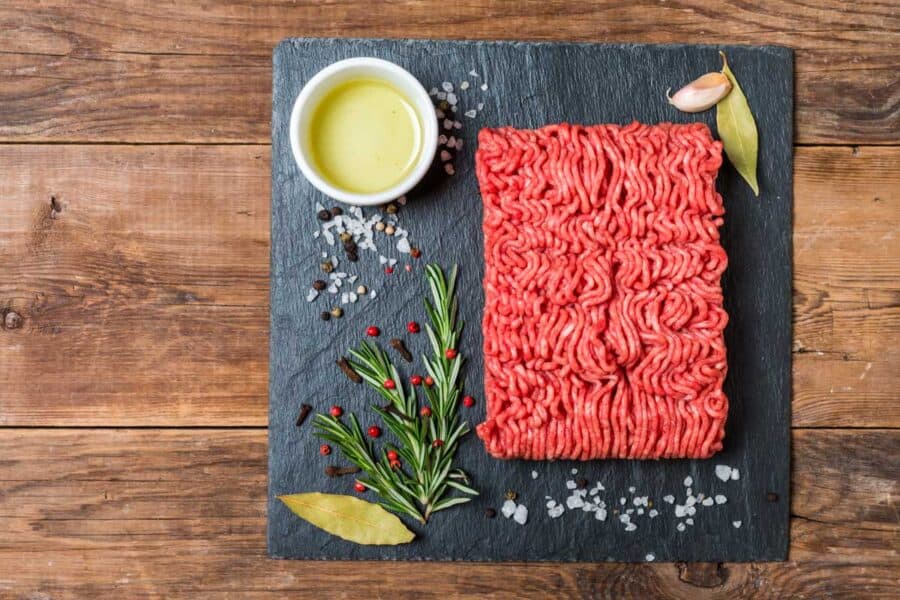
This page may contain affiliate links. Please read my privacy policy.
Using a jerky gun
Choose a LEAN package of ground beef. Don't use any beef that has more than 10% fat. When I make ground beef jerky I use 96% Lean / 4% Fat meat.
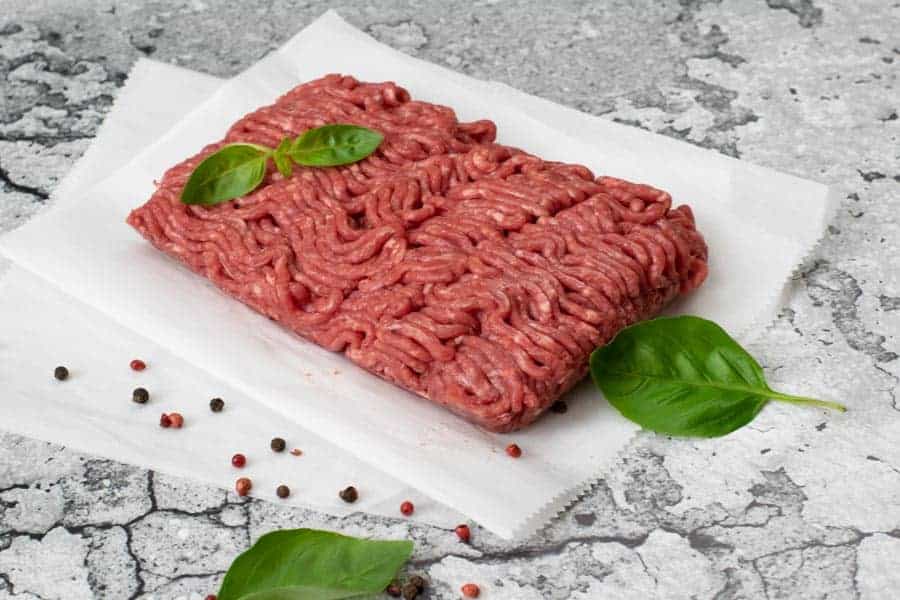
Season the meat with your favorite recipe, mix well with your hands, and refrigerate for 3-24 hours so the meat can bind together. Don't have a recipe? Not to worry, I have dozens of tested beef jerky recipes you can choose from. Most of these recipes were used on whole muscle jerky, but many will work for ground beef as well! Choose a recipe that has VERY little liquid ingredients. 1-2oz of liquid per 1 pound of meat is about the perfect amount. (1oz liquid = 2tbsp) If there are no liquid ingredients, COLD water can be used to help mix seasonings and meat.
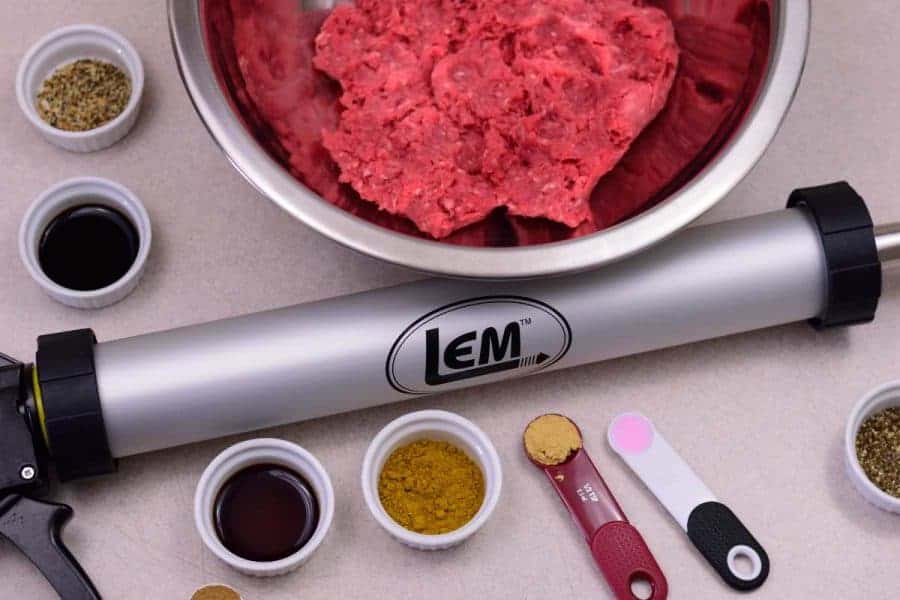
After taking your meat out of the refrigerator, pack the ground beef into a Jerky Gun a little at a time. Make sure that there are no air pockets within the meat when packing the tube. Air pockets will prevent the meat from being packed together and in long strips. I personally use an LEM Jerky Cannon which works great!
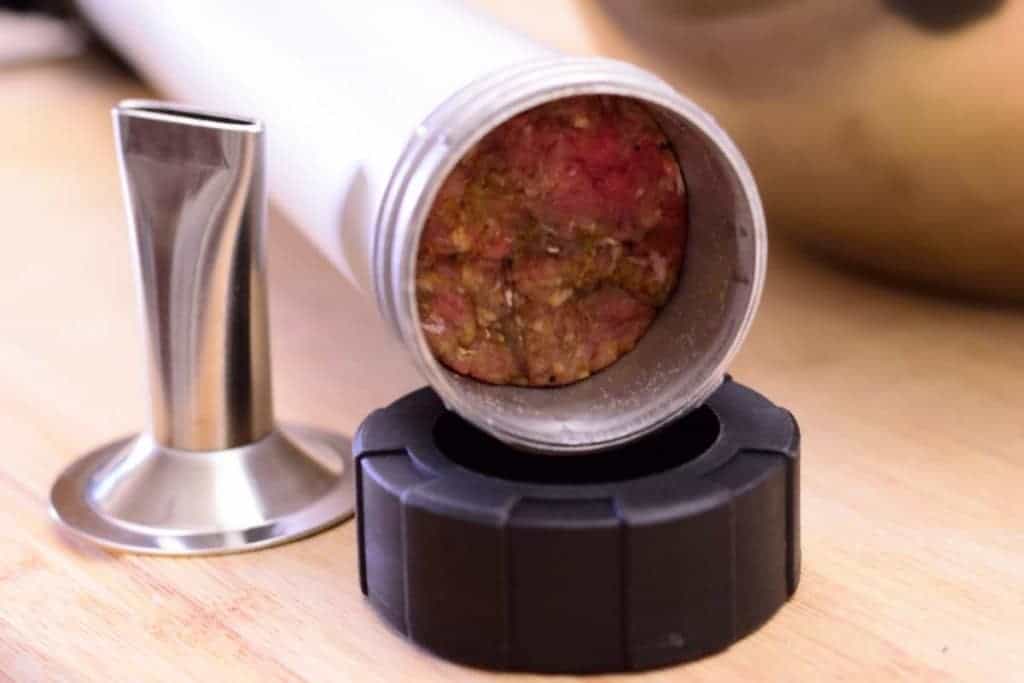
Shoot strips of jerky onto your dehydrator trays or on baking sheets if using an oven. Have a knife handy to cut the beef away from the nozzle after you make your strip the desired length so you can start another beef jerky strip. Shown below are trays from my Excalibur Dehydrator.
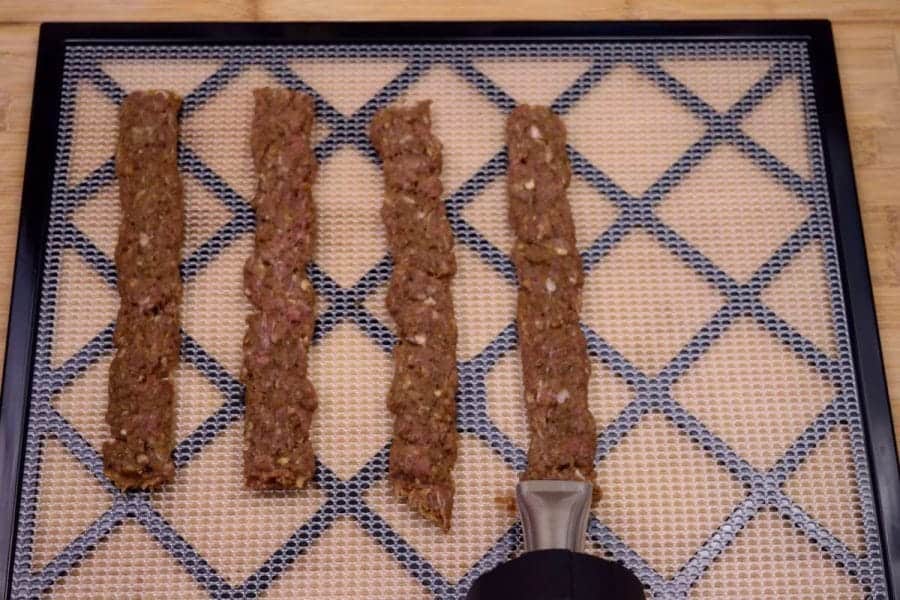
Dry at 160°F for 3-8 hours. Check after 3 hours and dry as needed checking every half hour.
Jerky will be finished when it bends without breaking in half. The jerky should still feel soft to the touch and not hard on the outside. ENJOY!!! You just made ground beef jerky! Yep, it's that easy....
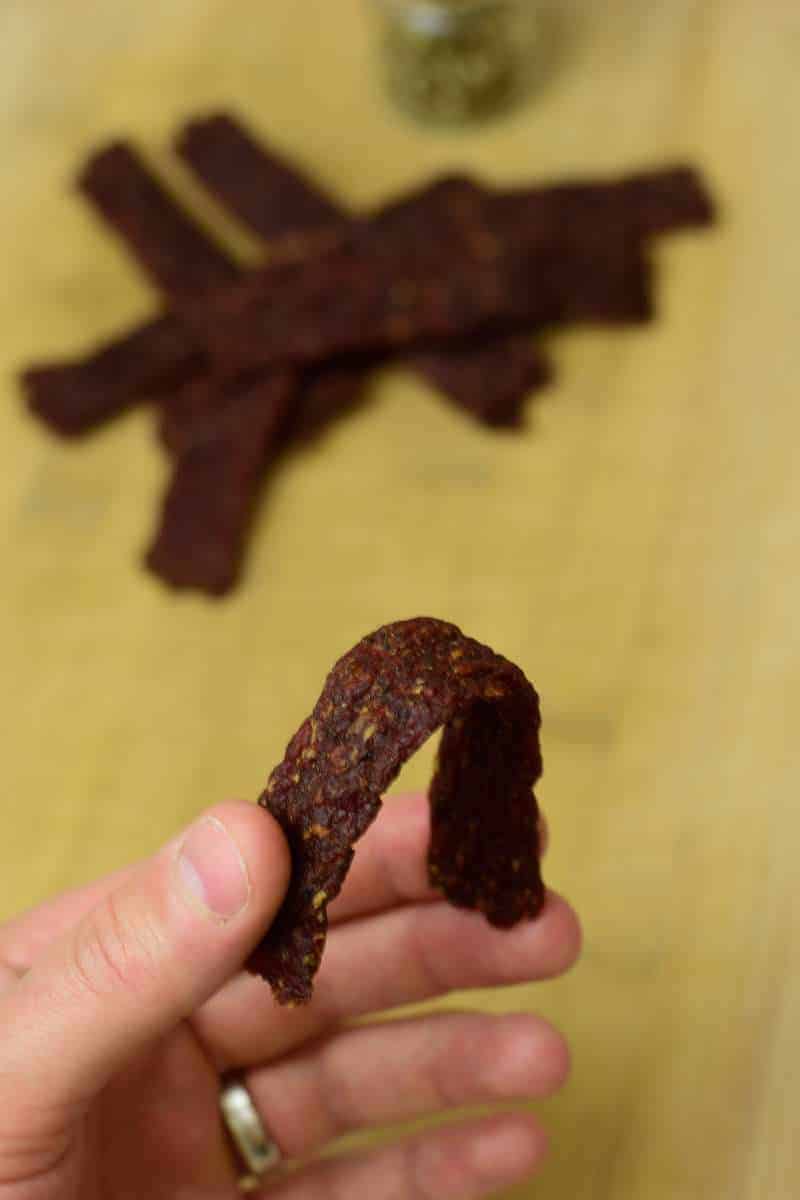
Ground Jerky Without a Jerky Gun
Start with the same LEAN package of ground beef that you would use if using a jerky gun.
Season the meat with your favorite recipe, mix well with your hands, and refrigerate for 3-24 hours so the meat can bind together. Don't have a recipe? Not to worry, I have dozens of tested beef jerky recipes you can choose from.
Below you can see my Coconut Ground Beef Jerky.
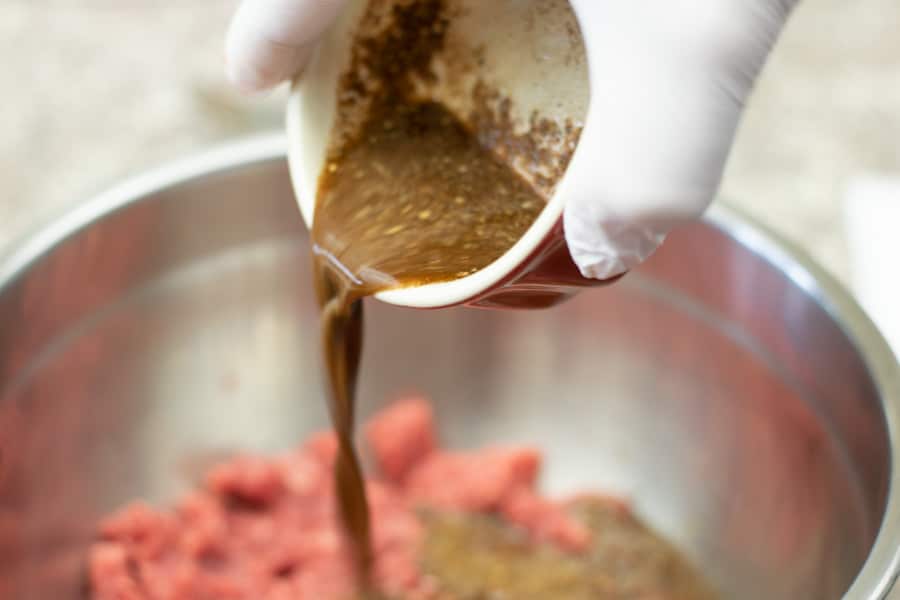
Most of these recipes were used on whole muscle jerky, but many will work for ground beef as well! Choose a recipe that has VERY little liquid ingredients. 1oz of liquid per 1 pound of meat is about the perfect amount. (1oz liquid = 2tbsp) If there are no liquid ingredients, COLD water can be used to help mix seasonings and meat.
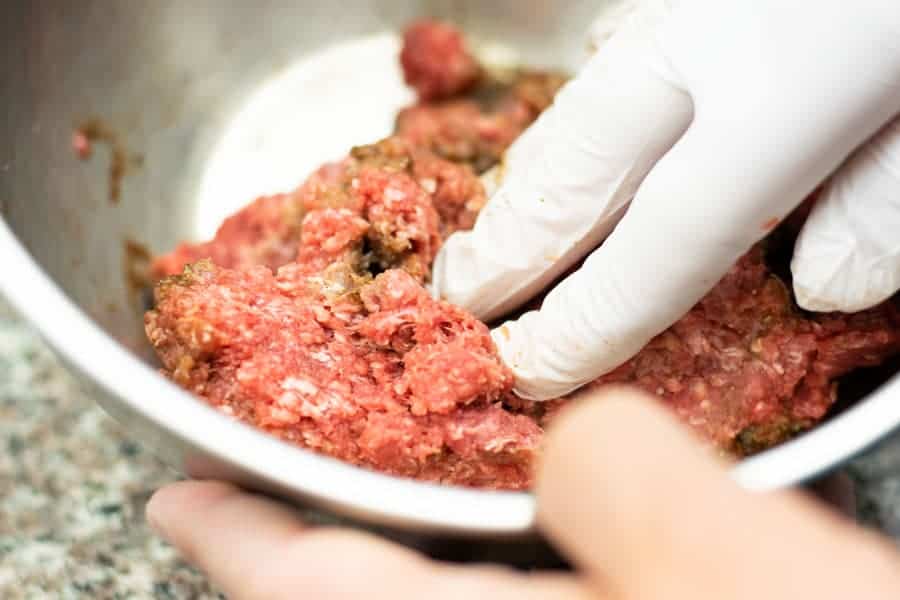
After taking your meat out of the refrigerator, place it on a cookie sheet lined with parchment paper. With the use of a rolling pin, flatten the beef to about a ¼ inch thick.
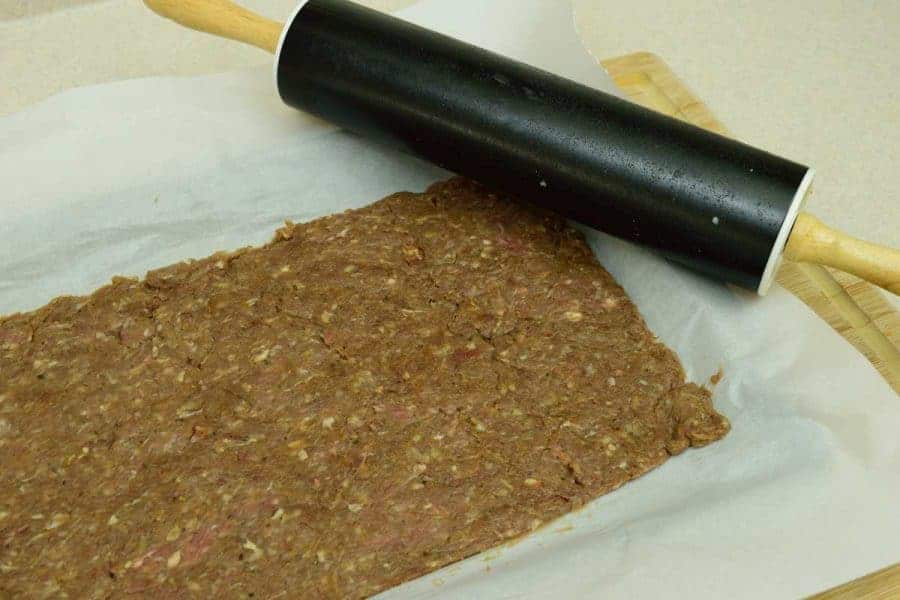
Score the jerky into strips with a dull knife or pizza cutter about an inch wide. Don't worry about making sure if they are completely cut all the way to the paper. You are just trying to score the strips so it will break apart easily after drying.
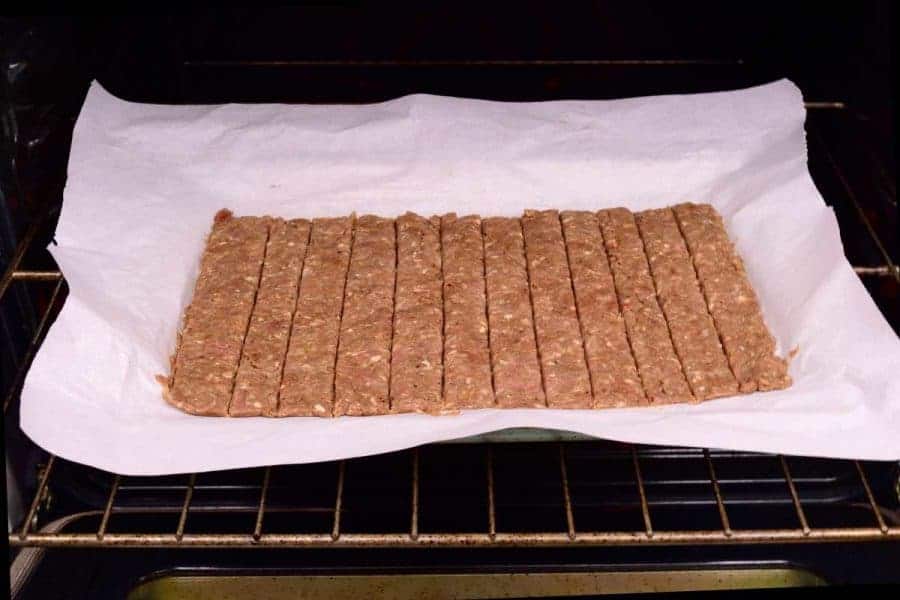
If drying in an oven, preheat the oven to 300° F. Place the beef inside and bake for 10 minutes with the door closed to pre-heat the strips to an internal temperature of 160°F.
Now turn the oven to 170°F or your ovens lowest setting and bake for 2 hours with the oven door partly open. (Stick a wooden spoon in the door to leave a small gap for air to circulate and escape) Flip the meat after 2 hours, pat dry with a paper towel, and continue to dry another 2 hours or until the jerky is finished.
The ground beef jerky will be finished when it bends without breaking in half. The jerky should still feel soft to the touch and not hard on the outside.
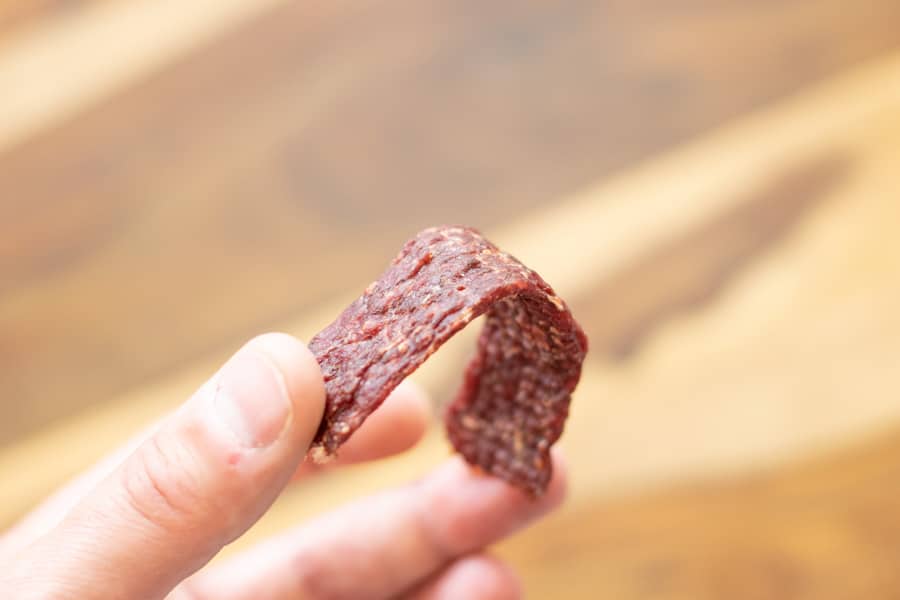
Food Safety Tips:
When making ground meat jerky you are dealing with meat that has been processed and ground making it have more surface area than whole meat and therefor more susceptible to bacteria. For this reason I recommend:
- Using latex gloves when mixing the ground meat with the spices as well as when loading the meat into the jerky gun.
- Make sure that a curing salt is used when making ground meat jerky. This step is optional when making whole muscle jerky, but for food safety, I highly recommend always using it when making ground meat jerky.
- Pre-heat the beef strips to an internal temperature of 160°F to help kill any potential bacteria. This should be done at the beginning of the drying process.
Related Posts:
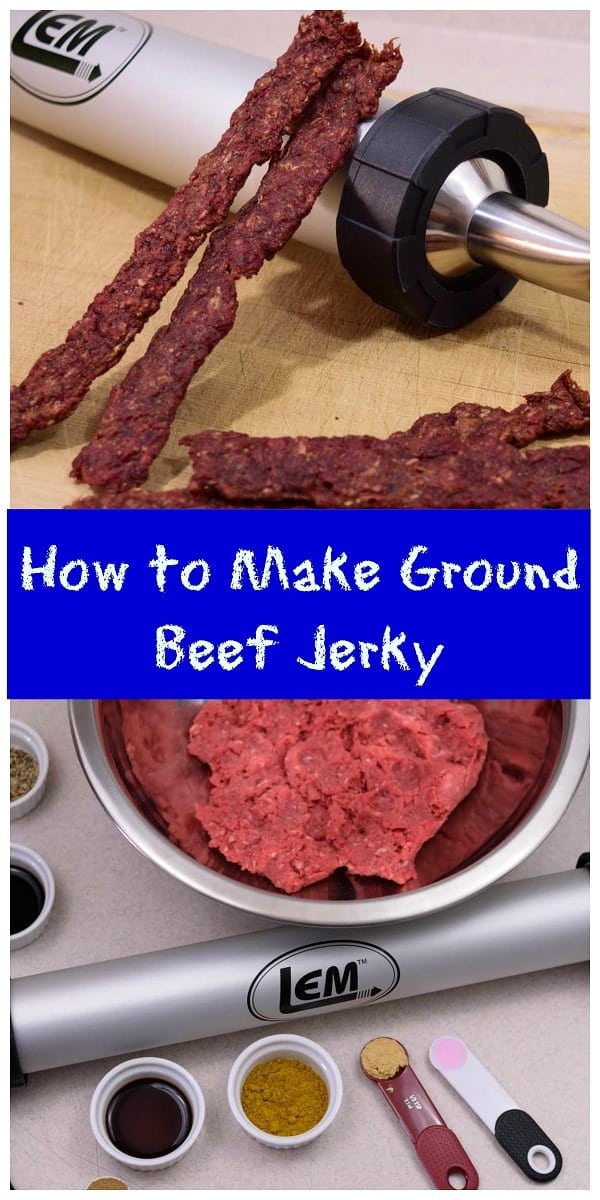


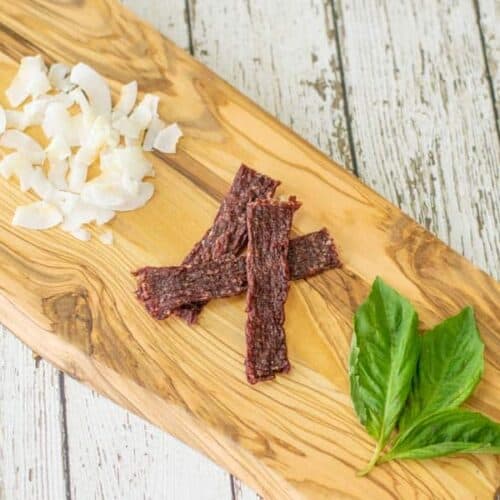
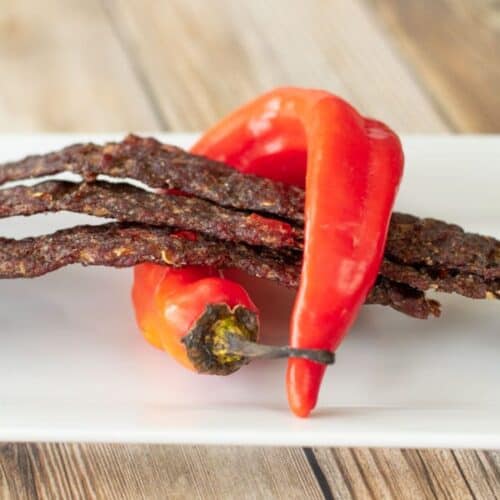
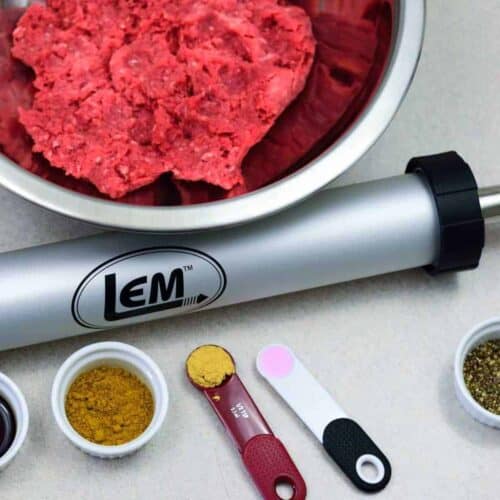
Tina Flanery says
What if your smoker only goes to 200?
Will says
If your smoker will operate well at 200 degrees, then that should work just fine.
Alberto Jose Martinez says
Good Morning.- Is it possible produce ground meat jerkys from an electric stuffer ; are available in the market any tubes for such a task?. Thanks You
Will says
I am not aware of any electric stuffers, I only use the jerky gun / cannon type to form into jerky strips.
Steve says
Hi,
Forget using jerky guns. Split a sandwich baggie. Roll a gob of your seasoned ground beef into a ball and place it on 1/2 of the baggie then fold over the other half of the baggie. Place two wooden paint stir sticks on each side of the baggie then roll it out with a rolling pin. Take your meat out and place it on your drying tray. After drying, cut it with scissors into any shape you like. So easy, I'm going to sell my jerky gun which is a pain to clean.
Charles Hamm says
I've recently got a Gourmia French door digital air fryer oven that has a dehydrate button the temperature can be set between 135°f and 170°f. I have started running test on different meats , fajita, a smoke brisket, and bottom round that was thin cut. I found the bottom round the thin cut is too thin, the brisket turned out good but I preferred the tenderness of the fajita meat the most. I'm thinking of testing the ground beef out but was wondering do I set it for 135 or all the way up to 170? I've already looked into a Wesson table clap strip cutter as well as getting a meat slice that raw or cooked meat can be sliced with. Is there any advice or other information that you know that can help make it easier . I live in a tent in the woods I have electricity but since I'm homeless was looking at wYd to preserve my meat since I don't have a normal refrigerator and this Texas heat I go through a lot of ice in the 2 chest I have. I used to live up there in Colorado, I was in Fort Collins. I'm actually thinking of coming
back up there to Trinidad to possibly live. One last thing thank you for publishing all the information that you have freely shared with us all. It has helped me save a lot of meat that I didn't have to just throw out cause it went bad.
Will says
Hey Charles! I have lived in Texas before and you are right, it's HOT! A lot cooler up here in Colorado. I would put the temp at 170°F when dehydrating to make sure the meat reaches 160°F internal to kill any potential bacteria for making both ground and regular beef jerky. I use that meat slicer and it works great on raw meat. My favorite is the Eye of Round roast sliced with the meat slicer. Turns out to a great thickness for jerky.
Raymond T. Johnston says
What temperature do you use for ground beef jerky in a pellet grill/smoker?
Will says
The lowest temp possible. Normally about 180F
Guillaume Lesage says
I like to put my meat and spices in the food processor and adding my spices while it's turning before I put it in the jerky gun. The texture is even in every strips.
Deb Stelzer says
Hi, Just wondering if I can add commercially prepared ground jerky to the hardtack I was intending to make? Just so that there is a little protein in the hardtack. Also can I use vacuum sealing and oxygen absorbers with this combination, or does the jerky make it more susceptible to spoilage?
Will says
The only reason I would see this as not working is if when you put the jerky into the hardtack, will it become hydrated at that point? I have never made hardtack and am unsure of how 'wet' the dough is when you are wanting to put the ground jerky in it. If it hydrates the jerky, it will no longer be jerky and will need to be refrigerated. It's probably best to leave the two separate and eat individually. If combined, the jerky will shorten the life span of the hardtack. They would need to be vacuum sealed.
Larry Smith says
Why in this world world you consider hardtack as a staple when we have so many alternatives to prepare for hard times?
Get on the stick and save water and yeast for bread and a hydrator for staples, vacuum sealed and frozen. A generator with plenty of fuel stashed a 100 gallons of water or a lake close by.
Are you on the march or home based?
Should have been my first question
Jennifer says
My dehydrator came with a jerky gun, cure and seasoning packets but minimal instructions so I've been reluctant to try, but your guidance has given me the confidence to do so. I'm looking forward to FINALLY getting to make my own jerky.
Thank you!
Will says
Hope it turns out well! Happy to help!
Deb says
Today is my first attempt at ground meat jerky. Only tried whole meat a couple of times, but while I was in an experimenting mood, and the fact that my jerky gun arrived yesterday, I thought "why not!". Using your Original ground Beef recipe and extra lean beef (don't know the exact %) with a couple of tweaks - I have a Birch BBQ sauce with tamarind in it - added 1 tbsp of that and took out one tbsp of Worchestershire, and added just a splash of honey - less than 1/2 tbsp. Dehydrator should be here next week, but in the meantime, I am doing it my convection toaster oven on cooling racks over a tray - so far the strips are holding up just fine. I have temp set for just under 200F and I have an oven thermometer in there. Temp moves up and down between 175F and 200F. I'll give it about an hour or so there and then turn it down a bit. I don't know how these are going to taste, but if the smell is any indication, MAN! Is this stuff going to be good! So glad I found your site as a raw noobie!
Deb says
Well the strips were less than satisfying. Only 2 hours in my convection toaster oven at about 160-165 (thermometer oscillated betw 150-175F) and they are dry & mealy - the texture was like "dry, already been chewed beef". They aren't dried out and cracking or breaking. Just not a good mouth feel at all. The toaster oven did great for whole muscle jerky so I don't know what could be the problem, unless the ground meat was TOO lean? Trying sticks with the rest of the meat (only used half for the strips) and see if that improves the outcome. Any suggestions? I'll be going back to traditional, whole muscle jerky unless i can find the problem and an answer. Tossed the strips. Sad. Smelled great, tasted OK if i could get by the dryness and the texture (I also think that is part of it - don't like the texture of the ground beef).
Jerry says
What ratio do you suggest again?
70/30, 80/20 for ground beef jerky?
Will says
93/7 or 90/10 at the most. Anything over 10% fat will create greasy jerky that will have a short shelf life.
Korey says
I use 70/30 all the time as that’s what’s usually on clearance. If you season it (include your curing salt) and put it in a zip lock then leave it in the ziplock in fridge overnight, a good portion of the fat will extract itself and stick to the plastic of the bag. Then while dehydrating flip every hour and dry each piece with a paper towel. When it’s done it will be awesome. But you do have to eat it quickly. More than a week in the fridge will make it moldy or rancid. Freeze in small bags for up to two months as long as you eat it the day you unfreeze it.
Dave says
I have a freezer full of grass fed ground beef gifted to me from a local meat processor. It looks like 70% lean. Can I cook the ground beef and boil it to extract the fat and then somehow make jerky?
Will says
If you try to cook it first before forming into strips, it won’t work. Making jerky with 30% fat would be very greasy and would not last long stored. It’s better to make some great tasting burgers instead!
Korey says
See my post above in response to a similar question from Jerry.
SamNYC says
Is 160°F really necessary? When I sous vide beef, 130°F-135°F for 1-2 hours is perfect for rare steak. Here, you are subjecting the beef to heat even longer, 4-6 hours.
I ask because not only are you subjecting the beef to longer times, but the beef is also soaked in a high salt marinade, which inhibits most beef pathogens. In fact, wasn't preservation the original reason for making meat jerkies and salt-based pickling?
Below is an USDA chart on pasteurizing poultry with 5% fat, which harbor much hardier pathogens than beef. We're normally told to cook poultry to 165°F, but that's somewhat simplistic because pasteurization is a function of both temperature and time. 165°F is for instant lethality, where all the pathogens are instantly killed. But if you subject the poultry to sustained heat, then much lower temperatures can be used. According to the below chart, it would take 2.8 minutes to kill the pathogens at 150°F, and 27.5 mins at 140°F. It goes up to 68.4 mins at 136°F.
In other words, you may not need an internal temperature of 160°F since dehydrating is such a long process, not to mention the high salt contents. Food for thought...
PS - love the site!
Will says
Hey Sam, thanks for the comment. The things you mentioned are true when cooking large pieces of beef or chicken in a way where moisture is involved. The difference when making jerky is that you are starting with meat that is sliced, or in this recipe ground which is further handled (increasing the potential of introducing bacteria) allowing more access for bacteria to contaminate all of the meat and not just the surface. The middle of a steak will not have bacteria as it mostly lives on the surface of meat, which is why it can be cooked to medium rare. Also, when dehydrating and slowly raising the temperature with the absence of moisture, bacteria can actually survive higher temperatures. This is why the USDA recommends heating beef jerky to an internal temperature of 160F for beef and 165F for poultry. All beef jerky sold is required to reach these lethality temperatures for the reasons I mentioned above. Can you make jerky at a lower temp and not get sick? Definitely, but it will leave the possibility of getting yourself and family sick.
Shirley Weeks says
I’m confused. For ground beef 93/7% how thin should I roll it out & hoe do you take the temperature of a thin piece of meat?
Will says
I normally roll it out to about 1/4" thick. It's hard to get a temp on such thin meat. I try to put an oven safe thermometer in the oven/dehydrator/smoker and wrap a very thin amount of meat around it, about 1/8" all around and leave it in the oven. This is the best way to get the most accurate reading.
Karen says
Hello. My first attempt at ground venison jerky did not go well. The texture was off. Kind of crumbly. Did I over dry it, too much fat (ground elsewhere with pork 80/20 I believe), did not mix it well enough? Your thoughts are appreciated.
Will says
Normally if the ground meat is crumbly it's either because it was over dried or because of the pre-heat in the oven. If you pre-heated the meat in the oven before dehydrating, that will change the texture and make it more crumbly. If you didn't do that, it probably was over dried. make sure that you remove a piece when drying and allow it to cool for 5 minutes, THEN check to see if it's finished drying. If you don't allow it to cool before checking, it will result in over drying. The jerky is more pliable when it's warm.
Yaron Dafni says
Is it possible to prepare ground meat jerky in a smoker?
Will says
Definitely. The grill grates are more than likely too far apart for ground meat however. You will need to use a grill mat that has holes or cooling rack to put the ground meat on first, then place that on the smoker.
Linda Gutenberg says
Thanks for all the great ideas and help. This week was my first time ever making ground meat jerky as we have always enjoyed the sliced jerky. Can I use the same recipes for ground as I can
for the sliced jerky. What a huge difference in the price. Love that. 🙂 Thank you,Linda
Will says
Happy to help! Most recipes can be made into ground jerky, the only thing you might need to change is the amount of liquid ingredients. If the only liquid in the recipe is water, only add 1/4 cup per 1lb of meat. If there are other liquid ingredients (soy sauce, worcestershire) keep the same ratio, but limit the entire amount to 1/4 cup per 1lb of meat.
Wayne K says
I am making ground meat jerky in an electric oven (convection oven) ,should I use or could I use the circulation fan to cure the jerky?
Will says
Is the question to use the fan only? I would use the fan to circulate the air around but you need to have the oven set to 170-200F to dry and heat the internal temp of the jerky to 160F.
SamNYC says
A convection oven is perfect if you can get it to a low enough temperature. The heat and circulating air is exactly what's needed for dehydrating foods. In fact, when I used a regular oven to dehydrate, I used to leave the door ajar and aimed a desk fan inside to speed drying. Leave a crack in the door to allow moisture to escape but be aware of insects and rodents. If pests are a problem, keep the door closed. Also, for safety reasons, many electric ovens won't function if the door isn't completely shut so an open oven may not be an option for you.
I have a large air fryer with a dehydration mode and it makes perfect jerky as well as dehydrated vegetables. The device is capable of temperatures from 100°F-450°F. Amazingly, it only cost $69 with free s/h. Essentially, you're getting a large 26liter air fryer, convection oven, broiler, toaster, dehydrator, yogurt incubator and sous vide machine for that price.
Aaron Kulkis says
Find the switch that looks like a long, thin press button, usually near the top edge of the oven door... Once located, place a small can against it as you allow the door to close against it. This will make the oven circuitry behave as if the door is fully closed.
Unfortunately, this doesn't work for modern washing machines that shut down everything completely, regardless of cycle (makes sense shutting down if the lid is opened during the spin cycle, but it doesn't make sense for stopping the water from filling the tub while you're loading clothes in).
Steve Yzm says
Thank for the info. I am using a masterbuilt smoker. I have 6 trays full with ground venison that has been marinating overnight. I will follow your advice as to amount of smoke, temps, etc. I rolled it out making sheets of meat that I will cut later. Any more tips for a rookie?
Steve.
Will says
Using a pizza slicer is great for scoring the meat into strips. Make sure to remove a piece of meat from the smoker and allow it to cool for 5 minutes before checking to see if it's finished drying. If you test it when it's warm, it will feel undone resulting in you drying longer and over drying it. Hope it turns out great!
Pam says
How can you tell if you have overdried it? I used my pellet grill/smoker. Some pieces are snapping after cooled. Was it on too long?
Will says
If it’s cracking in half, it’s probably over dried. Using a smoker is the hardest to get it dried just perfect. Easy to over dry it.
Lori says
How do you pack your jerky gun? I find it very difficult to pack my gun without air pockets . Thank you
Will says
Great question Lori, the best way I have found is start with the plunger at the end of the barrel where the nozzle will be screwed on. (meaning you haven't pushed the silver part in and pulled the plunger handle back) Now push the silver bit and pull the plunger handle/rod back 3 inches or so and place meat in the end of the barrel filling that now empty 3". Then pull it back another 3", it should pull the meat further into the barrel as you pull the handle back. Fill the end of the barrel again and repeat until the whole barrel is filled. Screw nozzle on and start pulling the trigger to extrude the meat from the nozzle end. I normally don't have any problems with air pockets if I fill it this way.
Joel P says
i am new to jerky making. have insta cure no.1 , it say 1 tsp for 5 lbs. and Uncle Abe's Seasoning 1 package makes 5 lbs. I have a 2lb package of ground turkey. If i mix 1/2 tsp of the cure and half the package of seasoning, do i need to add water? Also planning on using my Masterbuilt electric smoker at 160 for 4 hours (2hrs then flip) does that sound right?
Will says
Mixing 1/2 tsp would be fine, that isn't going to hurt you. If you want to make it more accurate for 2lbs, add just shy of 1/2 tsp of cure. I have never used that seasoning before but when I make ground jerky I do use water. Use up to 1/2 cup of water for 2.5lbs. Mix the cure and seasoning mix in about 1/3 cup of water then pour into the ground turkey and mix it together by hand. 4 hours is a good time to start checking the jerky. Make sure to remove a piece of jerky and let it cool for 5 minutes to room temperature before checking to see if it's finished. If you don't let it cool before checking to see if it's finished, you will more than likely over dry the meat. Good luck and thanks for stopping by the site Joel!
Joel P says
Thanks. It didn't come out bad for my first attempt